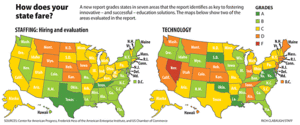Which states are innovative in education? A new report card.
The report card aims to highlight the sorts of innovations in education – such as an extended school day – that lead to better schools.

Rich Clabaugh/Staff
If states truly want to improve their education systems, they need to do away with the rules, regulations, and bureaucracies that stymie innovation.
That's one message from a new report that measures states on how well they foster education innovation, grading them in areas ranging from finance and school management to how well they hire effective teachers and remove ineffective ones.
Ultimately, say the report's authors, they hope not to prescribe new fads or "silver bullet" solutions, but to highlight the sorts of innovations that are leading schools where they need to go.
"A lot of the states have tried some things, but they haven't tried all the things we argue would be useful to creating a more innovative environment for success," says John Podesta, president and CEO of the Center for American Progress, one of the report's authors. "States have a lot to learn from each other."
The report, "Leaders and Laggards," has an unusual consortium of authors: the liberal Center for American Progress, Frederick Hess of the conservative American Enterprise Institute (AEI), and the US Chamber of Commerce – a bipartisan mix that the authors hope highlights just how much agreement can be found despite the fervent political battles that often surround education debate.
The authors, says Mr. Hess, AEI's director of education policy studies, disagreed about some details, particularly when it came to areas like school vouchers and tuition tax credits. "But we like to point out that even folks who look at the world from different perspectives can find a substantial amount of middle ground," he says.
He and the other authors agreed on the prime areas that states need to focus on if they want to foster innovative – and successful – education solutions:
•Having good management, which includes practices such as allowing models like charter schools to flourish and giving principals autonomy when it comes to running their schools.
•Setting up efficient methods of funding and spending.
•Hiring and evaluating good teachers.
•Removing ineffective teachers.
•Putting in place and using good data systems.
•Harnessing technology effectively.
•Having a strong pipeline to postsecondary education.
•Creating an environment that supports reform.
They graded states on all but the last (and most ambiguous) category, with a wide range of results.
Florida, for instance – one of the states with the best results – gets an A for its data systems (it can match individual students' test scores from year to year) and good marks for having a performance-pay system for teachers. But it gets a D on its efforts to ensure students' college and career readiness and an F for its ability to remove ineffective teachers.
Other states performing well in some (though not all) areas include Texas, Louisiana, Georgia, and New York.
States like Nebraska, Hawaii, and Nevada, meanwhile, receive abysmal grades in at least a few areas and don't shine in any.
The report highlights certain innovations that are already bearing fruit, such as early college high schools in which students can earn college credits, and an extended school day and year in charter schools like KIPP.
But the point, emphasizes Hess, isn't to suggest that any of these programs is the right approach for all districts or students.
"We're saying, 'Look, what would it take for states to create the room and opportunity for problem solvers to do better by kids?" Hess says. "What can states do to get out of the way, and how can they facilitate this in a manner sensitive to outcomes and quality?"
The first "Leaders and Laggards" report, published two years ago, focused on educational effectiveness. This one says "OK, you looked at all this, made some initial improvements; where do you go next?" says Thomas Donohue, president and CEO of the US Chamber of Commerce.
He and the other authors hope that the new report will dovetail, at least to an extent, with the ways in which the federal government is trying to spur reform and innovation through its Race to the Top Fund.
-----
Follow us on Twitter.
